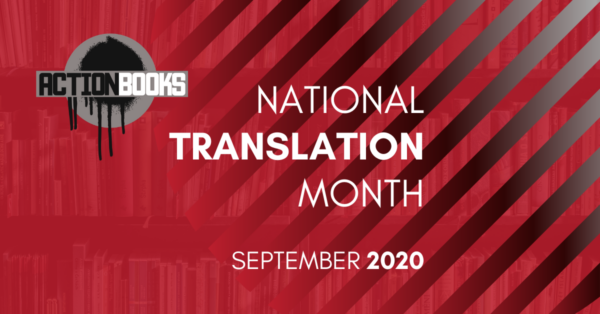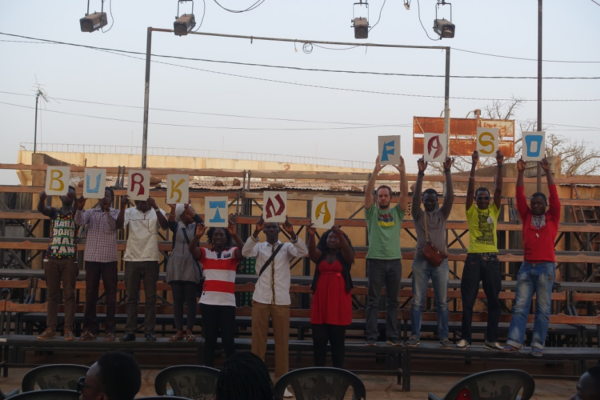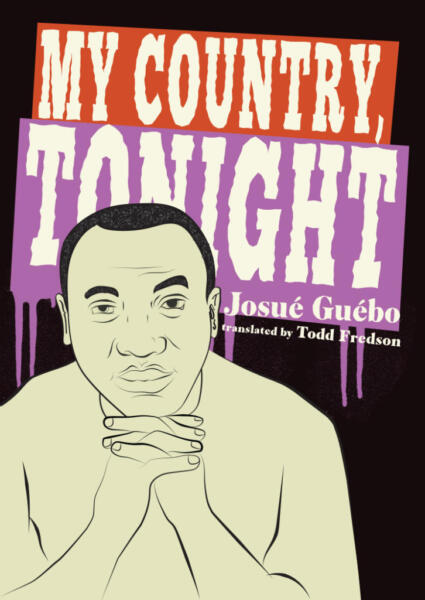
The following is an adaptation of a presentation given for The Colonial, Postcolonial, and Decolonial Research Cluster and the Institute for Humanities Research at Arizona State University.

So, I have, basically, a bullet point list of issues—limitations that literary translation efforts often run up against. When I say that these are limitations, what I mean is that they tend to reduce the complexity of whatever “otherness” is being engaged through translation. In the effort to establish grounds for relation, translators risk making “otherness” familiar rather than decolonizing our own thinking or asking our English-language readers to decolonize their thinking.
The way that I’ve confronted the tendency toward familiarizing is through a sustained, immersive relationship with the place from which I translate: West Africa. Though, even if a translator has established a psychological and emotional residence with and long-term community in a place, or is translating from their own native language or place of origin, these limitations often persist.
As I go through my bullet points—there are four—I’ll offer illustrations from some of the translation work I’m doing. Inevitably, points and issues will sprawl and overlap, and my illustrations will often serve more than one point.
- Often, what gets translated is guided by a translator looking to share something “representative” of a socio-political event or national attitude (or, even, literary heritage).
Frequently, even unconsciously, perhaps, the translator-author relationship is built on shared affinities—there is an ideological accord, for example, even if cultural difference.
If I look at three of the books I’ve recently translated, they’re all by writers from Cote d’Ivoire. Each book deals directly with the ethnic and political violence that took place from 2002-2011 across two civil wars (and which has returned in the lead-up to the October 2020 presidential election). The conflict has had largely to do with national identity and land tenure—who has the right to the land and its resources, who really belongs there. It was easy for me to understand the perspective of these first two authors, Josué Guébo and Tanella Boni. They worked in, to me, familiar paradigms.
Josué Guébo understands the conflict in broad geo-political terms, the result of the “aggression of Western economic systems,” in his (translated) words, the results of policies by the World Bank, the International Monetary Fund, France, and the UN, which he calls out in My country, tonight. This aligns with criticisms by decolonial thinkers regarding Structural Adjustment Programs and neocolonial agendas.
Tanella Boni explores the rupture that comes with the ethnic violence, a new dimension to periodic political violence and protests against the elites and corruption that, for a few decades, had united the country’s plurality. She places this ethnic violence within an historical context, associating it with other sectarian and ethnic violence inside and beyond Africa. Her historicizing point of view in The future has an appointment with the dawn is also readily recognizable to me, as translator, as a consumer of international headlines.
The third author, Azo Vauguy, however, defends an ideological position that most of us, especially those of us with our university training, would balk at. Zakwato is a book-length poem, a myth that Vauguy translated out of its oral keeping and ethnic language, Bété, into written French. He adds to the title, so that my Land never sleeps again. The hero of the myth, the warrior Zakwato, models the awakening of a revolutionary consciousness in the face of foreign invasion. However, this awakening, this sprung consciousness, advocates for an ethno-nationalist agenda. It’s this strict nativist perspective that led to violence against those perceived or cast as immigrants, other West Africans (or Ivorians) who do not belong to the land, who have invaded the country’s south and the Bété homeland. That interpretation is available once you are familiar with the country’s socio-political dynamics. The long poem is certainly not written for outsiders, but nor is it propaganda. It’s a well-accomplished poetic rendering of the Zakwato tale.
I wrestled with those two things—the accomplishment and the ideological underpinning, which supports a nativist point-of-view that’s troubling to a mind trained by cosmopolitan liberalism. It made me consider how often translators seem to be wholeheartedly allied with the authors that they translate, supporting works that they find morally or ethically favorable. But it’s helpful, also, to access thinking, beliefs, and values that are not as intuitively acceptable. While these first two poets are very recognizable in the Afro-francophone and African literary scene, Vauguy is not. It took time in-country for me to find this book, and it took several visits with Vauguy himself to understand the Bété cosmology and cultural references within the poem. For me, it’s one of the most interesting projects I’ve done and offers a very real expansion of the conversation around the Ivorian and other post-colonial African conflicts.
- Often, translations favor aesthetics that can fit within a recognizable (read, Western) literary and critical framework.
If you are reading this then I assume you already have an interest in translation. If that’s true, then this point is probably familiar to you. But let me approach it from the position of African translation work.
If I say that a work fits within a conventional Western literary framework then I am basically saying that it fits into a Euro-American literary market. A common complaint directed toward European contests and publishers supporting African literature is that support is dictated by a certain kind of “African-ness” that must be already legible to readers. The subject matter cannot be too foreign. The same goes for forms. A work, though, might not be categorizable according to Western genre conventions. You, as a journal editor, for example, may not “like” the aesthetic of a translated poem, but, then, do you want only to reproduce aesthetics that you’ve been trained to recognize and appreciate?
Artist, writer, and performer Werewere Liking points out:
Dans les arts de la parole chez moi, il n’y a pas a pari ‘le conte’, a part ‘le roman’, a part ‘la chanson’, a part ‘le theatre’. Dans le texte, qu ‘il soit de I ‘epopee comme le Mvet, le N ‘dinga, ou des recits lyriques ou simples, ou des poesies, tout est dans un tout. Quand on parte, on a beaucoup de niveaux de langue: subitement ca peut devenir un dialogue, ca peut devenir un passage lyrique, et puis ca peut devenir completement prosaique et narratif, case melange — c’est ca le texte.
In the speech arts of my people, we do not have these separate categories between what is ‘a story’, or ‘a novel’, or ‘a song’, or ‘a drama’. Our texts, such as the Mvet or the N‘dinga, or the simple or lyrical narratives, or the poems, include everything. Many levels of language are available for the oral artist: from dialogue, he can move directly to a lyrical passage, and as swiftly into a prosaic or narrative passage. Everything is mixed — that’s what the oral text is for us. (Osifan)
Combinations such as Liking describes, do not easily enter the Western literary field, except perhaps as anthropological or folklorist specialty projects. Vauguy’s long-poem, Zakwato, which translates the Bété myth, illustrates this point. It is borne out of the Bété ethnic heritage and its references are local.
Works that require such rich cultural context do not translate conveniently. Even oral forms, which are more familiar to American readers with the increased visibility of slam poetry and spoken word in the US, face restrictions. There is a functionality that often goes along with oral forms in Africa that may not transfer.
I worked with slam poets in Ouagadougou, Burkina Faso to try and translate some of their work, which I mostly failed at. The Slam poetry scene is very connected and robust across West Africa, even across languages. Declamation does not require access to publishers, nor a “high” literary education. There is less gatekeeping. One consequence is that there are many more women involved than in written poetry. But the poems often serve a function—they are a site of public discourse. So the references are, again, often too local or transient in time for a readership across continents.
For a street level view of the Slam scene in West Africa and how folks who participate and spectate define its impact, you might enjoy (even if you don’t understand the French) this short documentary film produced by Mahamadi Balima, who has been active in the Slam scene for several years.
Let me briefly introduce what a griot is, in case you are not familiar with this genre of performance: within African societies, historically griots have kept the tales of their communities, and performed a range of social functions—“perform” being a key word here. Griots transmit cultural knowledge, expose social habits, and morally instruct by performing. I think the griot’s art is often considered anachronistic or extinct in the Western imagination because it is associated with a cultural homogeneity that has mostly dissolved in urban life. However, the tradition continues to be revitalized within literature, by the Slam scene, and in rural spaces.
Poetic texts from rural spaces, generally, challenge Western genres. I worked, for instance, with a griot, or chanteur-poète (singer-poet), in northern Cote d’Ivoire. Mamadou Soro Peter makes his living installing glass commercially and residentially, and he writes and performs in Senoufo, a majority language in that region of Cote d’Ivoire and across its border. He plays the balafon as accompaniment. I don’t speak Senoufo, so with Peter and another helper, I translated songs to French, then to English. You can find a the lyrics for Peter of Korohogo’s song “The False Word” here: https://jacket2.org/commentary/miraculous-constructions-todd-fredson-ivorian-oral-traditions#lyrics. And you can hear the original poem, Le Mot Blasphème, performed here.
Again, we might talk about these texts in terms of function, as practices rather than artifacts.
Think of wailing this way. At West African funerals, wailers are typically hired. Dr. Soupé Lou, a professor in the theater department at the main university in Cote d’Ivoire, when I mentioned how much trouble I was having finding women poets, suggested that my sense of the genre, “poetry,” was really my limiting factor. She suggested wailing as a poetic form—a form that is exclusive to women. It is a performance. It is improvisational but also practiced, also based on conventions, and performed, usually collectively.
In her article, “Writing in Emergency Conditions or the Unequal Sharing of the Senses,” Tanella Boni identifies production that is marginalized in the marketplace as “fringe” literature—marginalized because it is written in a language with limited market potential, or because the work represents a social world that seems unimaginable for non-local readers. Borrowing from Jacques Rancière, she observes that such restrictions result in an “unequal sharing of the senses,” an impoverishment of human expression. Optimistically, she adds:
However, I dare to believe that it is from these distant parts, which remain largely unknown, that pockets of fresh air circulate, original and sometimes inaudible breaths, foreign accents able to shake off the rational or calculated arrangement of that ‘world republic of literature’ that Pascale Casanova speaks of (Casanova, 2008). (Boni)
A lot of “rural” production is slotted as folk art, a distinction that disallows a full representation of African and diasporic poetics within the literary realm. And here we can see that these distinctions, “folk art” and “literary,” made for the sake of organizing study and enabling marketability, are simply legacy products of Enlightenment rationale (categorize, dissect, penetrate, know)—making such distinctions is a colonial practice that continues to generate borders and blind spots.
- Often, translations favor recognizable forms of modernity (read, metropolitan).
My examples for restrictive genres and literary frameworks have just provided for this point.
Zakwato, for instance, provides a “rural” or non-Metropolitan view of post-coloniality. The oral forms of the griot and the wailers also challenge metropolitan visions of modernity, which often rely on technological or economic notions of “development” and discount the lives of those who will not untether themselves from kin or land relationships for the sake of ascending the capitalist ladder as an individual unencumbered.
- Sometimes there are parts of the world, or languages within parts of the world, such as in sub-Saharan Africa, that just don’t see much translation.
This is the crux of Boni’s point about “fringe” literature and market marginalization.
Three Percent, which began tracking literary translation in the US in 2008, reports that between 2008 and 2018 only six poetry collections from the countries of sub-Saharan Africa were translated. Three of those are translations that I did. The other three are important, selected works, but none of those authors are contemporary. I’d wager that the numbers for poetry collections for contemporary poets from sub-Saharan Africa in the several decades prior to 2008 were even bleaker. We still mostly reference poets from the Négritude era when we talk about Afro-francophone poetry. They’re important, but, also, as a literary movement, Négritude ended 60 years ago. There have been several generations and literary cycles since.
And, of course, translations are often from the most-colonial of the languages in a region. For example, Cote d’Ivoire, a country the size of New Mexico, is home to more than sixty ethnic languages in addition to French. Pierre Joris points to this colonial-language restriction for translations of North African, or Maghrebi, literature. Translation from the region is rare, and of the three literary languages, French, Tamazight (Berber), and Arabic, most translation work is limited to French-writing North African poets.
This fourth point is probably just the result of the limitations I’ve discussed in the first three. Like I said, the issues sprawl, overlap. They co-produce one another. Taken together, they do, though, indicate how self-centered our process for moving a text across languages and from one audience to another often becomes, intentionally or not.
Works Cited:
Boni, Tanella. “Writing in Emergency Conditions or the Unequal Sharing of the Senses,” Museum International, UNESCO, Vol. 61, No. 4, 2009.
Joris, Pierre. “Politics & Translation.” Association of Writers & Writing Programs Conference, 9 Feb. 2017, Washington DC. Conference presentation.
Osofisan, Femi. “Warriors of a Failed Utopia?: West African Writers Since the 70s.” Centre for African Studies, University of Leeds,
http://lucas.leeds.ac.uk/article/warriors-of-a-failed-utopia-femi-osofisan/. Originally published African Studies Bulletin, vol. 61, 1996, pp. 11-36.

Todd Fredson is the author of two poetry collections, Century Worm (New Issues Press, 2018) and The Crucifix-Blocks (Tebot Bach, 2012), which won the Patricia Bibby First Book Award. He has published translations of three books of poetry by Afro-francophone authors: The future has an appointment with the dawn (University of Nebraska Press, 2018) by Tanella Boni, which was a finalist for the 2019 Best Translated Book Award and for the 2019 National Translation Award; Think of Lampedusa (UNP, 2017) by Josué Guébo; and My country, tonight (Action Books, 2016) by Josué Guébo. Fredson has been awarded Fulbright and NEA fellowships. Find him at toddfredson.com.
